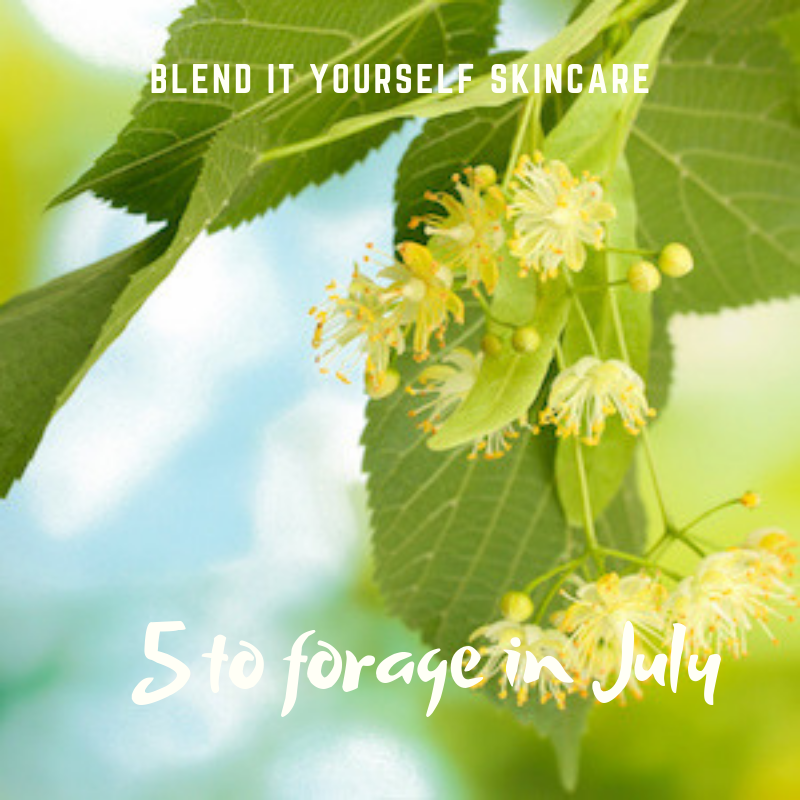
5 TO FORAGE IN JULY
Summer is rolling along now and most of us in the UK have at last had a sight of sun. A wet and cold June paid havoc with the early summer blooms but everything seems to be on catch up now so there’s plenty to get out and forage for your own blend-it-yourself skincare.
We’re spoilt for choice of things to gather in these high summer months. Here are some suggestions and you can follow the links to videos and recipes for more advice. Enjoy them fresh now, and also take time to create herbal macerations or dry plant material for use throughout the year.
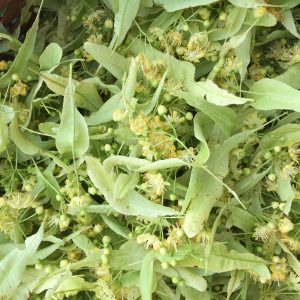
LIMEFLOWER
In early July if you’re anywhere near a lime tree there’ll be a sweet scent in the air, and possibly the humming of buzzing bees too. Majestic lime trees can go relatively unnoticed the rest of the year, despite their size, but in July they become show stoppers. Limeflowers are in bloom for just a couple of weeks, so do ensure you gather as soon as you see the flowers open, you might not get a second chance. Gather from the branches you can reach (leaving the higher up supplies for the bees) and collect a good basketful, they dry easily and you can store them for use through the year.
Happily you can gather the bracts along with the flowers and use them in just the same way. See this video to know what you’re looking for.
Once you’ve gathered your flowers, use them fresh or lay them out to dry and then store in an airtight container in a cool, dark place.
Limeflower tea is traditionally drunk to soothe both mind and stomach. To put its soothing properties to the test in skincare, why not try a comforting limeflower footbath. Here’s how.
Limeflower is one of the infused herbs that ensures Field Fresh Skincare’s Face the Day Cream gives you a calm start to your day.
Loving lime flower? there’s more to read about it here.
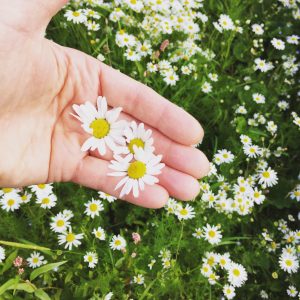
CHAMOMILE
Chamomile is just coming into flower. Its name comes from the Greek ‘chamamelon’ which means ‘apple of the ground’. There is certainly a strong appley-scent when the plant is trodden on. It’s also sometimes referred to as ‘pineapple weed’.
There are two main types of chamomile – Roman and German. Roman chamomile is the type used in chamomile lawns; German chamomile is what you will find in field edges and along paths – always seeming to shift its location each year as the seeds are moved around on the feet of people and animals. Both can be used in skincare, and may be blended together.
Chamomile is an astringent herbs, good to use in cleansers. It’s gentle so can be used on most skin types. It can be calming, soothing and softening for the skin. Just like a bedtime drink of chamomile tea. Chamomile is also well known as a hair lightener, most effective on blonde hair when used for successive rinses. It will condition hair too.
To get the best from chamomile, create an infusion and use this on its own – as a hair rinse or toner perhaps, or incorporate it into a blend with other ingredients. Field Fresh Skincare’s Essential Sensual Body Moisturiser starts with an infusion of chamomile and calendula – both gentle, caring herbs to soften the skin.
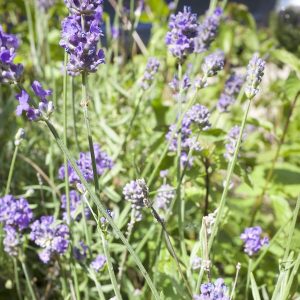
LAVENDER
Every garden I visit at present seems to have a lavender in flower. There are so many varieties. Each time I move to a new house, lavender is the plant I want to get established in my garden first. I ensure a good supply of something with high oil yield, like Lavender Grosso, and then keep adding more plants when things take my fancy.
Lavender essential oil is well known as a treatment for burns (it’s one of the only essential oils you can apply directly to the skin). The healing and antiseptic qualities also come through when lavender is used in other forms – such as infusions and macerations. This makes it a good herb for use against acne.
Perplexingly, lavender is both refreshingly stimulating and calming. I like to think it takes you as it finds you and seeks to help, whatever. A great addition to most products, you can include lavender in creams, tinctures, deodorants, and baths.
If you have a good supply of lavender, it’s worth taking the time to make your own lavender water. There are various ways to do this, depending on how strong you want it and how long you want it to last. Last month I shared techniques for making rosewater, you can apply the same methods using lavender to add to your stock of beautiful floral waters.
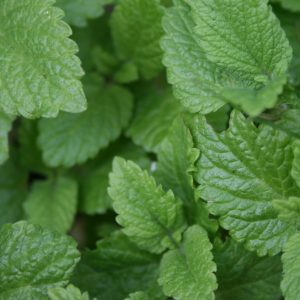
LEMON BALM
Lemon balm is said to mend a broken heart. The essential oil it yields is considered the best resource for pain, heartache and grief. Known as Melissa, (from ‘mel’ for honey) it is loved by bees.
Once established in a garden, lemon balm will typically self-seed vigorously. Popping up everywhere, it’s distinctive lemon-scented leaves make it easy to identify. It does have small white flowers too, but these are often rather indistinct.
In skincare, lemon balm is another good addition to a hair rinse, especially for greasy hair as it is astringent. It will add scent to the bath and has the potential to ward off insects (though not as effectively as it’s lemony friend citronella). Use an infusion of lemon balm leaves in these products, or otherwise, macerate lemon balm in oil to add to lip balms (where it will help treat cold sores) and you can also put it into deodorants.
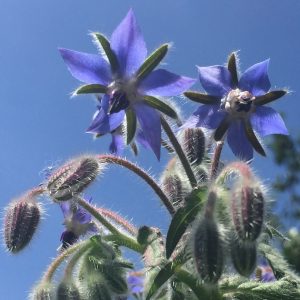
BORAGE
Often with plants the clue to their use is in their appearance. The ‘Doctrine of Signatures’ philosophy took this thinking to extremes, but it’s often the case that a plant will try to tell us how it can help, if only we can tune in and listen to it.
Borage has rough, hairy leaves and stem making it seem dry. The oil yielded from the borage seed is rough, and borage in all its forms – as a plant seed oil, or as an infused or macerated plant, is good for dry skin.
Borage is also known rather elegantly as ‘starflower’ thanks to its blue star-like flowers that are abundant at this time of the year. Sometimes morphing into shades of purple and pinks. These are exceptionally pretty (especially floated in summer drinks or scattered over salads). The anthers cluster making a black centre which is sometimes referred to as it’s ‘beauty spot’ – rather apt for a skincare plant I think.
Now is the time to gather leaves from borage, as the flowers begin. Use these fresh or dry for infusions later in the year. Here’s a video showing you borage growing in my garden and hanging in my drying shed.
LIKE THE IDEA OF GATHERING YOUR OWN SKINCARE INGREDIENTS? …
… you might like to read some more.
For everything you need to know to get started with Blend-it-Yourself skincare using the plants that grow around you, see Vital Skincare by Laura Pardoe. This book takes you through the techniques and ingredients you’ll need to know to make your own natural skincare.
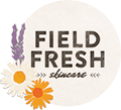

[…] can gather fresh limeflowers in early July, there’s more about them in the 5 to forage in July blog. Limeflower is traditionally considered a calming herb, used avidly on the continent as a tea […]
[…] year (in early July), so that’s a rare treat, there’s more about gathering them in the 5 to forage in July […]
Wow… I haven’t tried it yet but its indeed something I would definitely try and try to put some in my backyard too, I also like to keep Aleo and Sun Flowers (summer) around 🙂
Great to hear. Flowers make you happy, they’re good to have around.